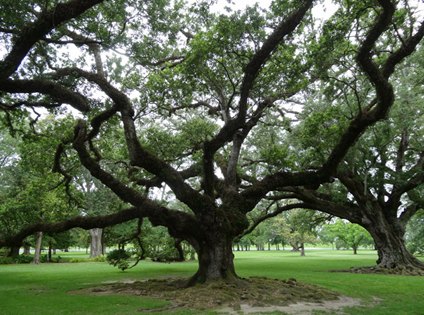
| Home | Source Reduction | Friends of Green Friends | Newsletters |
| Gardening | Resources | What You Can Do | Embracing The Trees |
|
Southeastern ETT Tree Planting Guidelines |
Tree Planting for our Changing ClimateAmma has asked us all to plant trees in order to support our environment. Here in the Southeast Region of the US it is a vast area comprised of many differing ecosystems and climates with so many aspects to think about when planning to plant trees.According to an Article from the USDA (US Department of Agriculture), Forests and Climate Change in the Southeast USA, "Southeastern forests are as diverse as the cultures that exist in them. The wide range of tree, plant and animal species make the region both resistant and susceptible to change. Some species will not be able to adapt to rapidly changing climatic conditions, other species will fill vacated niches that develop." The information that follows is just a small recommendation for the different regions within the Southeast. Always check with the experts in your area. Overall, planting Native plants will bring your highest chance of success in adaptation and toleration of changes in our climate. These changes include warming temperatures, sea level rise and drought. The USDA Hardiness Zones are important guidelines for planting where you live which take into account the average temperatures in a particular region. According to scientists, these zones are shifting north as our planet warms. Consider planting species that tolerate a wide range of temperatures when deciding what to plant. Also, along our coastal regions, we must consider the inevitable sea level rise with more salt content in our soils. Many State, University and Federal agencies provide services to order trees, communicate with the experts and participate in regional events. Shopping at Native local nurseries is preferred to obtain well grown plant species. These websites are packed with information. Here are just a few: |
Southeast US Tree and Plant Resources
|
Southeast Forest Ecosystems
|
Some Species to Plant for our Changing ClimateRed Maple Acer rubrum (USDA Hardiness Zone 4-9) A beautiful tree that is considered a generalist or one that tolerates many habitat conditions. Red Maple does well in moist and dry soils, low or higher elevations but especially loves moister sites with acidic soils. Not specifically able to tolerate aerosol salt but it is a perfect inland species which grows in full sun to partial shade up to 75 feet and is often planted in neighborhoods.Yaupon Holly Ilex vomitoria (USDA Hardiness Zone 7-10) A native shrub to small tree, the red berry provides food for wildlife in the fall and winter. This salt tolerant species likes moist soil with good drainage and grows well in shade to part sun. Often used in landscape plantings it is widely available in local nurseries both dwarf and full-sized varieties can be propagated from branches and seeds . Live Oak Quercus virginiana (USDA Hardiness Zone 8-11) This long-lived large tree loves moist well drained soil. With its spreading branches, and large size it is considered high in its carbonsequestration potential. Southern Live Oaks are also salt tolerant. Though it takes a long time to grow large, these trees make a beautiful addition for a large space and will live as long as 300 years. Black Mangrove Avicennia germinans (USDA Hardiness Zone 9-12) A small tree or shrub that may grow to 120ft. Found primarily in salty saturated tidal coasts. The Black Mangrove is the most cold tolerant mangrove. They are suited to waterfront on saltwater canals and lagoons and makes a good hedge. May be propagated using sea pods of older trees sprouted in moist mud. Sea Hibiscus Hibiscus tiliaceus (USDA Hardiness Zone 10a-12a) This large shrub (40 ft) grows well in both wet salty and dry soils. As an ornamental it has showy flowers and lush foliage. In addition, the bark, roots and flowers are medicinal and the wood has been used as floats and canoes. Due to its leaning trunks, it can help stabilize sand dunes and muddy shores. Propagation can be achieved using a large branch of another bush, stripping the leaves and placing it in moist soil for rooting. Bald Cypress Taxodium distichum (USDA Hardiness Zone 4-10) This is a moderately slow-growing tree that thrives in poorly drained wet habitats but is drought tolerant once it is established. Reaching 60-80ft. at maturity, propagation can be achieved from seeds and cuttings. This species is considered high in carbon sequestration due to its large size and lifespan of sometimes 600-2000 years. Red Cedar Juniperus virginiana (USDA Hardiness Zone 2-9) A significant source of food and shelter for wildlife this moderate to long lived evergreen is known to be tolerant of a wide range of extremes. Drought, heat, cold and salt tolerant Red Cedar is a good consideration to plant when thinking of global climactic changes. Plant in full sun to part shade, mature trees have been known to grow to 50 or more feet tall with some specimens living 500 years. |
| Home | Source Reduction | Friends of Green Friends | Newsletters | Resources | What You Can Do | Embracing The Trees |
For more information, e-mail info@greenfriendsna.org |
||||||
